Supermicro with Greenlow Motherboards at SuperComputing 15
by Ian Cutress on November 24, 2015 3:59 PM EST- Posted in
- Motherboards
- Intel
- E5
- Enterprise
- Trade Shows
- Supermicro
- Skylake
- v5
- Greenlow
- SC15
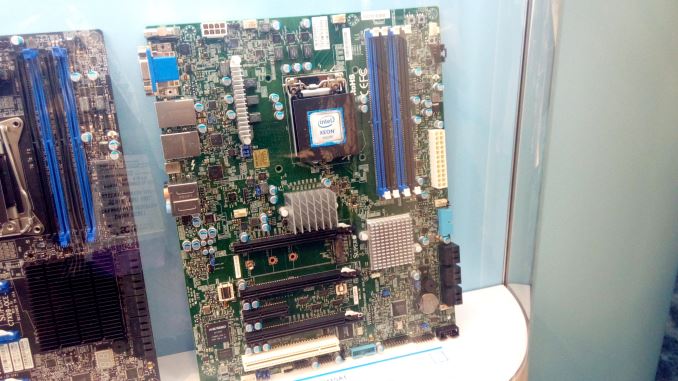
One of the bigger shakeups of the Xeon ecosystem of late is the recent discovery that Intel will be severing the few ties that the Xeon family of processors from the consumer arm of the company. While it is still fundamentally the same microarchitecture underneath with the same amount of pins, and there are a few additional features on the Xeon, it was mentioned (rather than announced) that the Skylake Xeon processors would not be coded into the consumer motherboard microcode, and thus be non-qualified for the 100-series chipset motherboards. This means that if you need a Skylake Xeon, you need a C230 series motherboard which is meant to be a higher validated chipset part over the consumer ones. This leads to the Greenlow platform, where a Skylake Xeon in the format E3-1200 v5 is paired with a C230 series chipset.
At SuperComputing 15 this past week, Supermicro had a few of their workstation based Greenlow motherboards on display.
As you might imagine, they essentially very similar to the 100-series motherboards we have already seen, except with minimal styling and a few workstation focused features. This one is the X11SAE-M, a micro-ATX design that uses eight individual SATA ports at right angles from the chipset as there is only one PCIe 3.0 x16 slot for a PCIe accelerator card. Note the use of PCI (!) as well, and a power delivery subsystem of only five phases. The pre-requisite COM/TPM headers are here, along with two SuperDOM, a PCIe 3.0 x4 based M.2 slot, and two Intel NICs with one being pro-focused with another low power.
The X11SAE-F is the bigger brother, extending the feature set to dual PCIe 3.0 long slots in an x16 or x8/x8 configuration, doubling the PCI slots, and equipping the board with an AST2400 controller chip to allow for remote management. There is also a Thunderbolt header in play for PCIe based TB cards.
We also caught wind of the X11SAT which looks more like the consumer ATX parts, however this one uses a PLX chip under the mid heatsink (I assume it’s an 8747, and not a 9000 sries part) that gives x16/x8/x8 layouts for the PCIe slots. There is also an Intel Alpine Ridge controller, which the blurb states supports Intel’s Thunderbolt as well as Type-C to DisplayPort and USB 3.1.
These should all be part of a larger SM stack of boards, and currently in the hands of SM’s sales people and common distributors. We’re hearing word that some of the Greenlow boards, covering both server and workstation, should offer quad-1G NICs, or dual 10G, some with LSI 3008 RAID controllers on board and even one with four PCI slots (for long-life legacy applications).


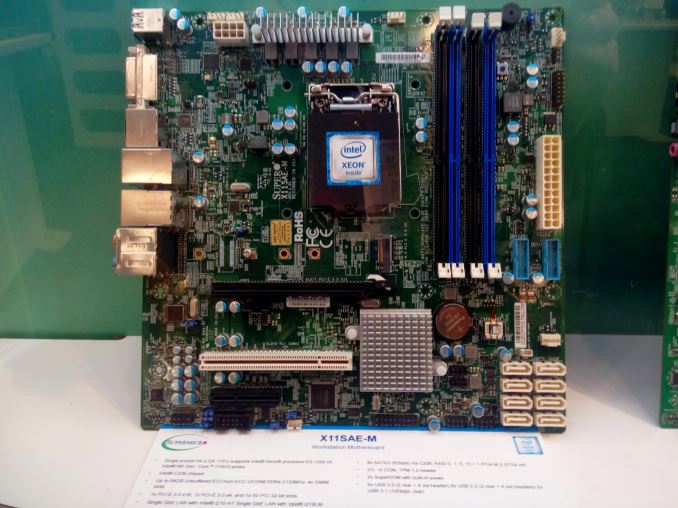
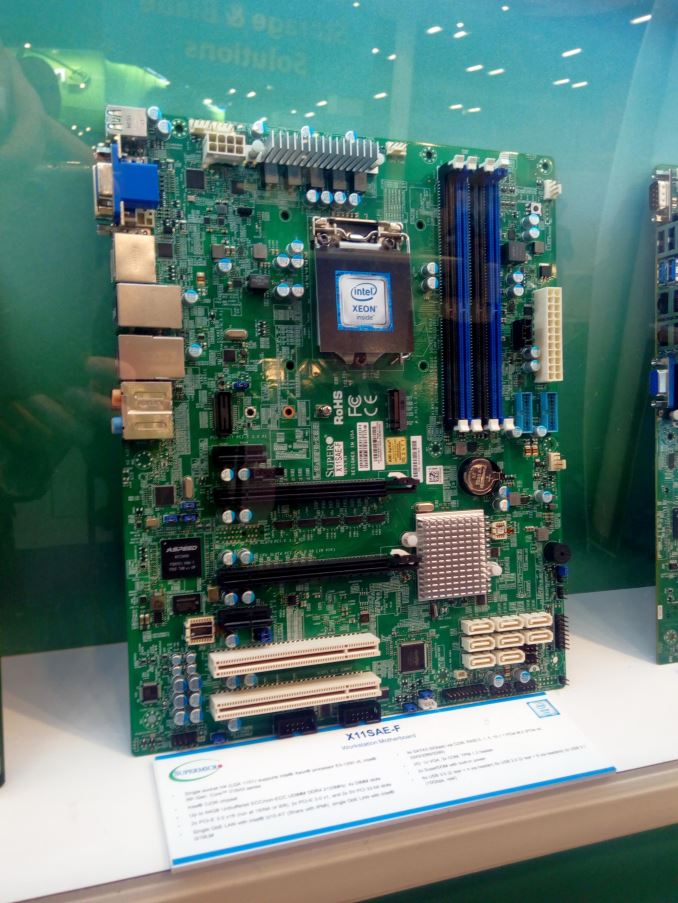
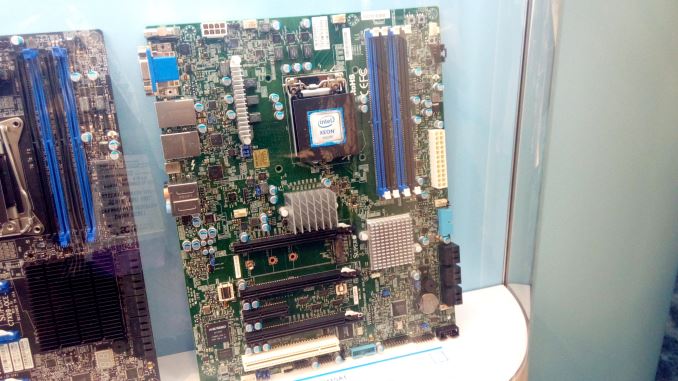
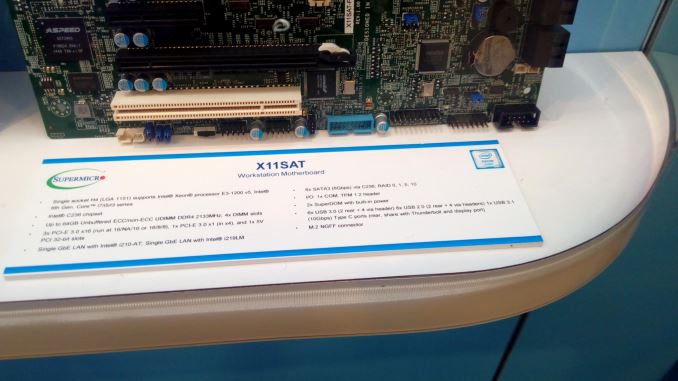








14 Comments
View All Comments
jasonelmore - Tuesday, November 24, 2015 - link
i really dont understand Intel's reasoning from banning the new Xeons from Z100 unless they just didn't want to do the minimal backend coding to keep them compatible.If they were compatible they would sell more CPU's. i'd guess C230 chipset is similar in cost to a H170.
dsumanik - Tuesday, November 24, 2015 - link
Because intel has no competition right now and can do whatever it want's out of convenience or cost savings. Welcome to capitalism at it's finest.Would be lovely if Apple decided to start competing with intel directly with arm and x86 chips. They have enough money and engineering resources to potentially do it....though i shudder at the potential prices lol
jasonelmore - Tuesday, November 24, 2015 - link
apple doesn't have a fab, and none of these 16nm processes are doing big chips yet (GPU's, Quad Core with GPU). By the time they do, intel will be tapping out 10nm.Plus Apple does not have a x86 License, they would have to buy out AMD for that. Could try and use arm but the world uses x86 for mid-range to high end compute.
Dahak - Wednesday, November 25, 2015 - link
Even if they did want to buy out AMD for the X86 License, I believe it has been stated elsewhere in rumors that if a buyout did happen, the X86 license is non-transferable anyway, so you would lose 80% of the reason for buying amdMr Perfect - Wednesday, November 25, 2015 - link
That's what I thought too, but the last time I said as much some guy here said it was transferable. I don't remember his source though.rtho782 - Wednesday, November 25, 2015 - link
But if Intel refuse to license x86 to you as AMDs new owner, you refuse to renew their AMD64/x86_64 license. I think Intel would cave before trying to force everyone to IA64.babadivad - Thursday, November 26, 2015 - link
As I understand, if AMD is bought out, the x86 license isn't transferable AND intel gets to keep the AMD64 license. Win-Win for Intel either way.rtho782 - Thursday, November 26, 2015 - link
not according to section 5 of the agreement (that is published online). if you read it, bankruptcy of one party enables the other to carry on using the bankrupt partners tech, but change of control terminates it for both parties.Intel need amd64 almost as much as AMD need x86, so a new deal would be pretty easy to agree on.
rtho782 - Thursday, November 26, 2015 - link
change of control would be 5.2d(ii) in here:http://www.sec.gov/Archives/edgar/data/2488/000119...
the rights of both parties are terminated.
personally I want Samsung to buy AMD..
The_Assimilator - Wednesday, November 25, 2015 - link
"Would be lovely if Apple decided to start competing with intel directly with arm and x86 chips."Never gonna happen. In order to be a player in the desktop and server markets, you need an x86 license. x86 licensing is controlled by Intel and they will never issue another license.
ARM will never displace x86 on the desktop and server because ARM performance is, to be blunt, shit. Even if you ignore that, there's the whole legacy of software that has to be rewritten or recompiled, and retested, to work with ARM - that doesn't come for free.
Then there's the small fact that the only area ARM beats x86 is power consumption, and Intel is rapidly closing that gap with each new process node and architecture. In the long term, x86 will win, and it's the long term that companies look at; why migrate to ARM when it's probably going to be obsolete in 5 years anyway?
Finally, desktop is a low-margin high-volume market. Apple doesn't do low margins; why should they when every douchebag hipster is lining up to buy the next iPhone?